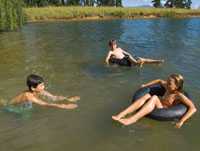Recreational Water Illness and Injury (RWII) Prevention Week 2011
 Having fun while you swim this summer means knowing how to prevent recreational water illnesses (RWIs) and injuries. Learn how to stay healthy and safe while enjoying the water!
Having fun while you swim this summer means knowing how to prevent recreational water illnesses (RWIs) and injuries. Learn how to stay healthy and safe while enjoying the water!
Swimming is one of the most popular sports activities in the United States(1). Although swimming is a physical activity that offers numerous health benefits, pools and other recreational water venues are also places where germs can be spread and injuries can happen.
 May 23–29, 2011, the week before Memorial Day, marks the seventh annual Recreational Water Illness and Injury (RWII) Prevention Week.* RWIs are caused by germs spread by swallowing, breathing in mists or aerosols of, or having contact with contaminated water in swimming pools, hot tubs, water parks, water play areas, interactive fountains, lakes, rivers, or oceans. RWIs can also be caused by chemicals in the water or chemicals that evaporate from the water and cause indoor air quality problems.
May 23–29, 2011, the week before Memorial Day, marks the seventh annual Recreational Water Illness and Injury (RWII) Prevention Week.* RWIs are caused by germs spread by swallowing, breathing in mists or aerosols of, or having contact with contaminated water in swimming pools, hot tubs, water parks, water play areas, interactive fountains, lakes, rivers, or oceans. RWIs can also be caused by chemicals in the water or chemicals that evaporate from the water and cause indoor air quality problems.
In addition to illnesses, injuries, such as drowning, can occur in and around the water. Drowning is the second leading cause of unintentional injury death among children 14 years old and younger. Prevention is important because water-related injuries are often severe. Of drowning victims treated in emergency departments, more than half are hospitalized and often experience brain injuries with long-term consequences. Visit CDC's Injury Center website for more information on water safety and drowning prevention.
RWII Prevention Week 2011 Theme: Swimmer's Ear Prevention
This year's RWII Prevention Week focuses on swimmer's ear, a common recreational water illness that can cause pain and discomfort for swimmers of all ages. Swimmer's ear is an infection of the outer ear canal that affects results in an estimated 2.4 million health care visits every year and nearly half a billion dollars in health care costs (2)
 Although it is a common infection, many people do not know the symptoms of swimmer's ear. Symptoms of swimmer's ear usually appear within a few days of swimming and include:
Although it is a common infection, many people do not know the symptoms of swimmer's ear. Symptoms of swimmer's ear usually appear within a few days of swimming and include:
- Itchiness inside the ear.
- Redness and swelling of the ear.
- Pain when the infected ear is tugged or when pressure is placed on the ear.
- Pus draining from the infected ear.
Swimmer's ear can occur when water stays in the ear canal for long periods of time, providing the perfect environment for germs to grow and infect the skin. Germs found in pools and at other recreational water venues are one of the most common causes of swimmer's ear.
Swimmer's ear cannot be spread from one person to another.
Prevent Swimmer's Ear
 You can help protect yourself and your family from swimmer's ear by following a few simple steps:
You can help protect yourself and your family from swimmer's ear by following a few simple steps:
DO keep your ears as dry as possible.
- Use a bathing cap, ear plugs, or custom-fitted swim molds when swimming to keep water out of your ears.
DO dry your ears thoroughly after swimming or showering.
- Use a towel to dry your ears well.
- Tilt your head to hold each ear facing down to allow water to escape the ear canal.
- Pull your earlobe in different directions while your ear is faced down to help water drain out.
- If you still have water in your ears, consider using a hair dryer to move air within the ear canal.
- Be sure the hair dryer is on the lowest heat and speed/fan setting.
- Hold the hair dryer several inches from your ear.
DON'T put objects in your ear canal (including cotton-tip swabs, pencils, paperclips, or fingers).
 DON'T try to remove ear wax. Ear wax helps protect your ear canal from infection.
DON'T try to remove ear wax. Ear wax helps protect your ear canal from infection.
- If you think your ear canal is blocked by ear wax, consult your health-care provider rather than trying to remove it yourself.
CONSULT your health-care provider about using commercial, alcohol-based ear drops or a 1:1 mixture of rubbing alcohol and white vinegar after swimming.
- Drops should not be used by persons with ear tubes, damaged ear drums, outer ear infection, or ear drainage (pus or liquid coming from the ear).
CONSULT your health-care provider if your ears are itchy, flaky, swollen, or painful, or if you have drainage from your ears.
ASK your pool/hot tub operator if disinfectant and pH levels are checked at least twice per day—hot tubs and pools with proper disinfectant and pH levels are less likely to spread germs.
USE pool test strips to check the pool or hot tub yourself for adequate disinfectant and pH levels.
Healthy and Safe Swimming Resources
 To help spread the message about healthy and safe swimming, CDC's Healthy Swimming Program and CDC's Injury Prevention Program have developed various resources, such as the Triple A's of Healthy Swimming, for the public.
To help spread the message about healthy and safe swimming, CDC's Healthy Swimming Program and CDC's Injury Prevention Program have developed various resources, such as the Triple A's of Healthy Swimming, for the public.
To view and download these and other materials—such as fact sheets, brochures, posters, videos, and podcasts—visit the Healthy Swimming Program's Resources webpage and the Injury Prevention Program's Resources webpage.
Enter CDC's Healthy Swimming Video Contest this summer!
Use your creativity to help educate others about healthy swimming behaviors and be eligible to win $1,000 and have your video posted on CDC's website to be seen by thousands of people. Video submission deadline is July 4, 2011. Go to the Healthy Swimming Video Contest webpage for more information.
Swim Healthy! Swim Safely!
* To highlight the important role injury prevention plays in healthy swimming, Recreational Water Illness Prevention Week changed its name this year to Recreational Water Illness and Injury Prevention Week. Going forward, the observance will continue to be known as Recreational Water Illness and Injury Prevention Week.
References
- US Census Bureau. 2010 statistical abstract of the United States. Recreation and leisure activities: participation in selected sports activities 2008 [PDF - 80KB].
- CDC. Estimated burden of acute otitis externa—United States, 2003–2007. MMWR Morb Mortal Wkly Rep.2011;60:605-609.
Get email updates
To receive email updates about this page, enter your email address:
Contact Us:
- Centers for Disease Control and Prevention
1600 Clifton Rd
Atlanta, GA 30333 - 800-CDC-INFO
(800-232-4636)
TTY: (888) 232-6348 - Contact CDC–INFO
 ShareCompartir
ShareCompartir


